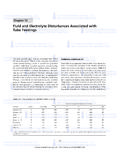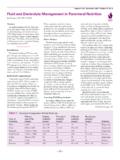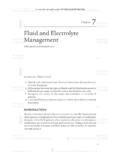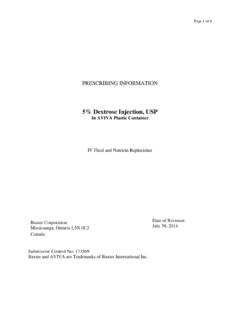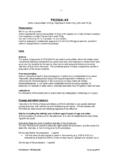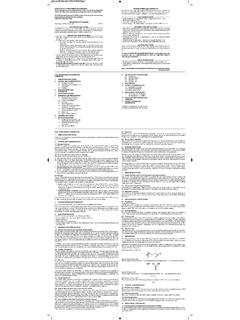Transcription of GLUCOSE AND SODIUM CHLORIDE - medsafe.govt.nz
1 GLUCOSE AND SODIUM CHLORIDE New Zealand Data Sheet GLUCOSE & SODIUM CHLORIDE NZ Data Sheet 26 October 2015 Page 1 of 15 Baxter GLUCOSE AND SODIUM CHLORIDE GLUCOSE SODIUM CHLORIDE infusion solution GLUCOSE 4% SODIUM CHLORIDE infusion solution GLUCOSE 5% SODIUM CHLORIDE infusion solution GLUCOSE 5% SODIUM CHLORIDE infusion solution Composition GLUCOSE (anhydrous) and SODIUM CHLORIDE in Water for Injections BP. Chemical Structure/Molecular Formula The chemical name of GLUCOSE is D-(+) glucopyranose.
2 Molecular formulae of GLUCOSE and SODIUM CHLORIDE is C6H12O6, and NaCl, respectively. DESCRIPTION GLUCOSE is a monosaccharide, having physical characteristics as a white crystal or granular powder and freely soluble in water. SODIUM CHLORIDE occurs as a colourless or white crystal and is freely soluble in water. GLUCOSE and SODIUM CHLORIDE infusion solutions are sterile, nonpyrogenic solutions. The concentrations of the active ingredients dissolved in a litre of Water for Injection are shown in Table 1 (see PRESENTATION AND STORAGE CONDITIONS). They do not contain an antimicrobial agent or added buffer, and have a pH of - They are iso-osmotic as indicated by their osmolarity shown in Table 1 (see PRESENTATION AND STORAGE CONDITIONS), except GLUCOSE 5% SODIUM CHLORIDE and GLUCOSE 5% SODIUM which are hypertonic solutions (with osmolarity of 586mOsmol/L and 432mOsmol/L, respectively).
3 GLUCOSE AND SODIUM CHLORIDE New Zealand Data Sheet GLUCOSE & SODIUM CHLORIDE NZ Data Sheet 26 October 2015 Page 2 of 15 Baxter PHARMACOLOGY Mechanism of Action GLUCOSE is readily metabolised into carbon dioxide and water, with a release of energy. As such, an administration of a GLUCOSE solution either by oral or parenteral route provides water for body hydration as well as energy (for conversion to kJ units, see Table 1 in PRESENTATION AND STORAGE CONDITIONS). In addition, it may reduce catabolic loss of nitrogen from the body and aid in prevention of depletion of liver glycogen.
4 That is, in the absence of GLUCOSE , amino acids undergo deamination followed by oxidation in order to release energy. SODIUM is the major cation of extracellular fluid and functions principally in the control of water distribution, fluid and electrolyte balance and osmotic pressure of body fluids. CHLORIDE , the major extracellular anion, closely follows the physiological disposition of the SODIUM cation in maintenance of acid-base balance, isotonicity and electrodynamic characteristic of the cells. Thus, GLUCOSE and SODIUM CHLORIDE infusion solutions have value as a source of water, electrolytes and energy. Pharmacokinetics As GLUCOSE and SODIUM CHLORIDE infusion solution is directly administered to the systemic circulation by infusion, the bioavailability (absorption) of the active components is complete (100%).
5 Excess SODIUM is predominantly excreted by the kidney, with small amounts lost in faeces and sweat. INDICATIONS GLUCOSE and SODIUM CHLORIDE infusion solution is indicated for replenishing fluid losses, as an energy source and for restoration or maintenance of SODIUM and CHLORIDE ion concentrations. It may be used as a vehicle of medication delivery where intravenous delivery is appropriate and the medicine is compatible with this solution. CONTRAINDICATIONS GLUCOSE and SODIUM CHLORIDE infusion solutions are contraindicated in patients with the following medical conditions: know hypersensitivity to the product known allergy to corn or corn products.
6 Because cornstarch is used as raw material for GLUCOSE production GLUCOSE AND SODIUM CHLORIDE New Zealand Data Sheet GLUCOSE & SODIUM CHLORIDE NZ Data Sheet 26 October 2015 Page 3 of 15 Baxter cardiac failure including congestive heart failure lactacidosis uncontrolled diabetes clinically significant hyperglycaemia hyperkalaemia severe impairment of renal function bloating-ascitic syndrome in cirrhosis acute ischaemic stroke patients who have had a head trauma within 24 hours patients presenting with a clinical state in which there exists oedema with SODIUM retention, or with renal, hepatic or cardiac impairment with oedema, hypervolaemia, hypernatraemia.
7 GLUCOSE and SODIUM CHLORIDE infusion solutions containing SODIUM CHLORIDE are contraindicated in patients presenting with severe hyponatraemia. PRECAUTIONS General The safety of the Viaflex plastic container used to contain GLUCOSE and SODIUM CHLORIDE infusion solution preparations has been confirmed in tests with animals according to the USP biological tests for plastic container, as well as by tissue culture toxicity studies. Nevertheless, care should be exercised regarding a possible incompatibility outcomes resulted either from the interaction between the plastic container or active ingredients and the added therapeutic substances (see also DOSAGE AND ADMINISTRATION).
8 When used as a vehicle of intravenous medication delivery, the product information document of these medicines must be examined to ensure compatibility with GLUCOSE and SODIUM CHLORIDE infusion solution. In a dilute condition, osmolarity/L is approximately the same with osmolality/kg. As shown in Table 1 (PRESENTATION AND STORAGE CONDITIONS), GLUCOSE 5% SODIUM CHLORIDE and GLUCOSE 5% SODIUM are hypertonic solutions (with osmolarity of 586mOsmol/L and 432mOsmol/L, respectively), whilst the other strengths are isotonic. The administration of substantially hypertonic solution may lead to a wide variety of complications. These include crenation (shrinkage) of red blood cells and general cellular dehydration.
9 The administration of GLUCOSE and SODIUM CHLORIDE infusion solution can cause fluid and/or solute overloading resulting in dilution of the serum electrolyte concentrations, GLUCOSE AND SODIUM CHLORIDE New Zealand Data Sheet GLUCOSE & SODIUM CHLORIDE NZ Data Sheet 26 October 2015 Page 4 of 15 Baxter over-hydration, congested states, or pulmonary oedema. The risk of dilution states is inversely proportional to the electrolyte concentrations of the injections. The risk of solute overload causing congested states with peripheral and pulmonary oedema is directly proportional to the electrolyte concentrations of the injections.
10 Thus, caution must be exercised when administering GLUCOSE and SODIUM CHLORIDE infusion solution to patients with or at risk of: hypernatraemia hyperchloraemia metabolic acidosis hypervolaemia conditions that may cause SODIUM retention, fluid overload and oedema (central and peripheral), for example: hypertension, heart failure including congestive heart failure, peripheral or pulmonary oedema, impaired renal function, pre-eclampsia or other conditions associated with SODIUM retention. Similarly, care should be exercised with the administration of these products to patients receiving corticosteroids or corticotropin, because of a potential SODIUM and water retention.










